Whimbrels (Numenius phaeopus) are on the move! After spending the winter along the tropical north coast of South America since September 2024, these long-distance migrants are now heading north. Their journey includes important stopovers in the southeastern U.S.—with key sites in Texas, Louisiana, Georgia, South Carolina, and Virginia—where they rest and refuel before continuing on to their nesting grounds in the far north of Canada and Alaska.

Right now, Manomet staff are in the field at major staging areas in Texas and Louisiana—places where whimbrels gather in large numbers to build up the energy they’ll need for the next leg of their incredible migration.

They’re not working alone. Manomet is collaborating with partners from the University of Oklahoma, the Louisiana Department of Wildlife and Fisheries, and the Cornell Lab’s Center for Conservation Media. Together, this team is studying how whimbrels use the landscapes of Texas and Louisiana, and gaining insight into every stage of the birds’ annual cycle—from migration and breeding to staging and wintering.

So far, the team has documented nearly 15,000 whimbrels through roost surveys at dawn and dusk. They’ve also outfitted 13 birds with lightweight tracking devices to follow their movements over the coming year—a key step toward better understanding and protecting this remarkable species.






 Back to all
Back to all